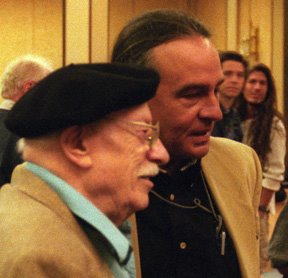 This is the Marine War Memorial in Arlington, Va. next to the national cemetery.
This is the Marine War Memorial in Arlington, Va. next to the national cemetery.The statue was inspired by a photograph, taken Feb. 23, 1945, at the top of Mount Suribachi, Iwo Jima.
U.S. Marines raised a large flag, replacing a smaller one, so it could be could seen by everyone on this Pacific island, only 750 miles south of Tokyo.
The Associated Press photographer Joe Rosenthal captured the instant.
After clearing the censors and being shipped to the states, the photograph became an instant icon of the Pacific action in World War II. The picture was for many years the number one selling image in AP’s archives.
Rosenthal was awarded the 1945 Pulitzer Prize for photography.
So what's wrong with this picture?
 Rosenthal passed away over the weekend at the age of 94.
Rosenthal passed away over the weekend at the age of 94.This is a picture of him taken in 2000, at the National Press Photographers Association’s annual conference in San Francisco, where he lived. He had joined other Pulitzer winners to explain the experience of taking the award-winning picture and talk about his career.
He is seen here with The Associated Press photographer Alan Diaz, who would be awarded the 2001 Pulitzer Prize for breaking news photography for his images of Elián Gonzalez. Gonzalez was a Cuban refugee whose mother drowned attempting to flee to the United States. He was taken by U.S. federal agents from relatives in their Miami home and reunited with his father, and then returned to Cuba.
Any self-respecting photojournalist will take a moment to think about Rosenthal.
There is nothing remarkable about the techniques Rosenthal used to make this picture; it’s the capturing the historic moment that is important. He had hesitated to climb Mount Suribachi, but did so anyway. When he got there, the scene unfolded, and he shot it with his 4x5 graphic camera.
He exemplifies an old photographic axiom – f-8, be there!
No comments:
Post a Comment